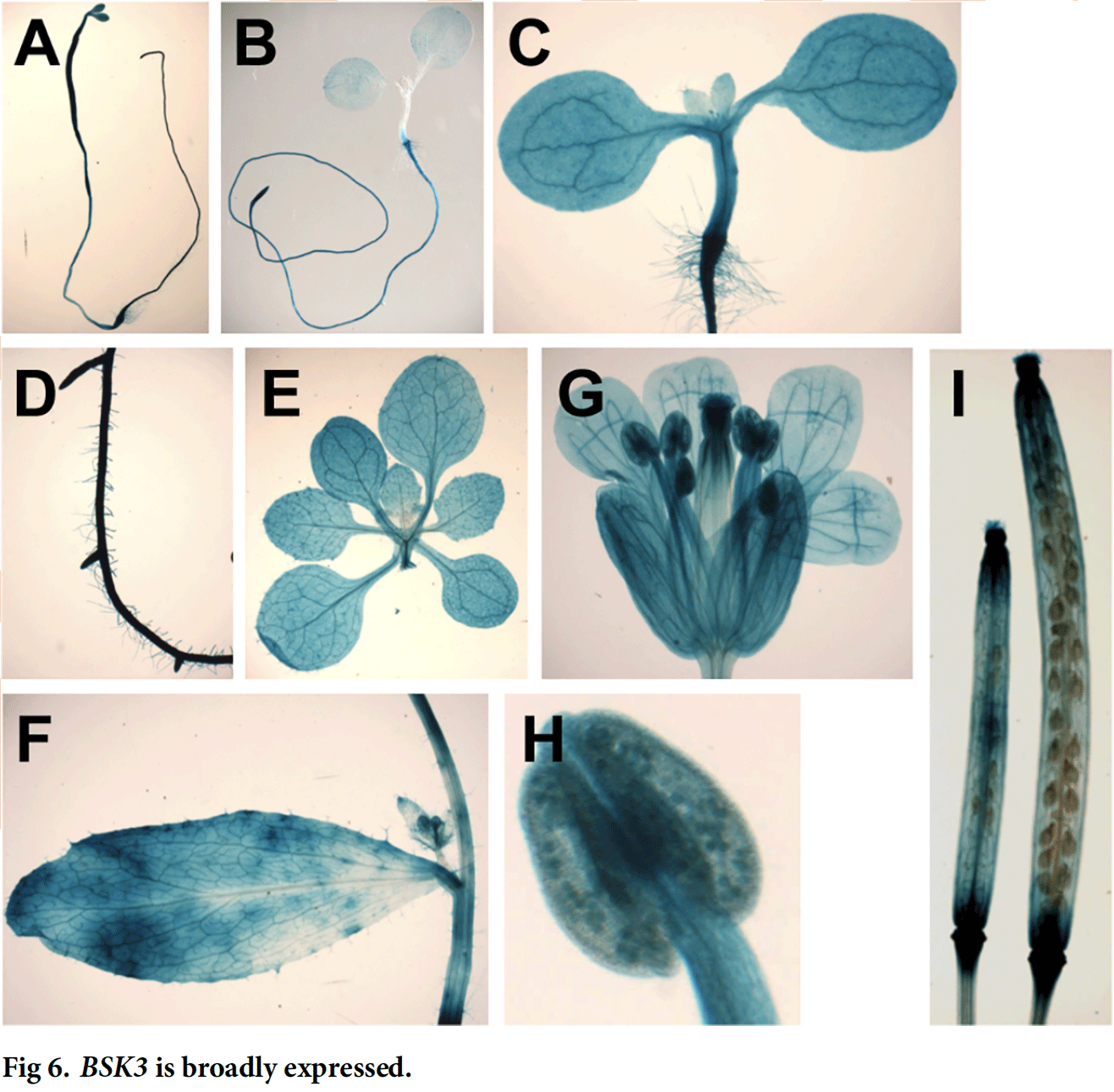博文
Plos Genentics:油菜素内酯信号通路上的支架蛋白BSK3
||
BRASSINOSTEROID-SIGNALING KINASE 3, a plasma membrane-associated scaffold protein involved in early brassinosteroid signaling
First author: Hong Ren; Affiliations: Howard Hughes Medical Institute (霍华德·休斯医学研究所): La Jolla, USA
Corresponding author: Joanne Chory
Brassinosteroids (BRs) are steroid hormones essential for plant growth and development. The BR signaling pathway has been studied in some detail, however, the functions of the BRASSINOSTEROID-SIGNALING KINASE (BSK) family proteins in the pathway have remained elusive. Through forward genetics, we identified five semi-dominant mutations in the BSK3 gene causing BSK3 loss-of-function and decreased BR responses. We therefore investigated the function of BSK3, a receptor-like cytoplasmic kinase, in BR signaling and plant growth and development. We find that BSK3 is anchored to the plasma membrane via N-myristoylation, which is required for its function in BR signaling. The N-terminal kinase domain is crucial for BSK3 function, and the C-terminal three tandem TPR motifs contribute to BSK3/BSK3 homodimer and BSK3/BSK1 heterodimer formation. Interestingly, the effects of BSK3 on BR responses are dose-dependent, depending on its protein levels. Our genetic studies indicate that kinase dead BSK3K86R protein partially rescues the bsk3-1 mutant phenotypes. BSK3 directly interacts with the BSK family proteins (BSK3 and BSK1), BRI1 receptor kinase, BSU1 phosphatase, and BIN2 kinase. BIN2 phosphorylation of BSK3 enhances BSK3/BSK3 homodimer and BSK3/BSK1 heterodimer formation, BSK3/BRI1 interaction, and BSK3/BSU1 interaction. Furthermore, we find that BSK3 upregulates BSU1 transcript and protein levels to activate BR signaling. BSK3 is broadly expressed and plays an important role in BR-mediated root growth, shoot growth, and organ separation. Together, our findings suggest that BSK3 may function as a scaffold protein to regulate BR signaling. The results of our studies provide new insights into early BR signaling mechanisms.
油菜素内酯BR是类固醇激素,作用于植物的生长和发育。BR的信号通路已经有了一定的研究基础,然而关于BR信号激酶BSK家族蛋白在该通路上的作用还不是很清楚。本文通过正向遗传学试验鉴定到了BSK3基因上的五个半显性突变导致的BSK3功能丢失,并且BR响应减弱。作者进一步研究了BSK3作为一个类受体胞质激酶在BR信号转导及植物生长和发育中的作用。作者发现BSK3通过豆蔻酰基化锚定在质膜上,这对于BSK3在BR信号转导中发挥作用是必需的。BSK3的N端激酶结构域对于其功能很重要,而C端的三个串联的TPR基序主要作用于BSK3/BSK3同源二聚体和BSK3/BSK1异源二聚体的形成。有趣的是,BSK3对于BR响应的影响是依赖于BSK3蛋白水平的计量效应的。作者通过遗传学试验显示激酶无效BSK3K86R蛋白能够部分拯救bsk3-1突变体的表型。BSK3直接与BSK家族蛋白BSK3和BSK1、BRI1受体激酶、BSU1磷酸酶及BIN2激酶互作。BSK3的BIN2磷酸化能够增强BSK3/BSK3同源二聚体和BSK3/BSK1异源二聚体的形成、BSK3/BRI1的互作以及BSK3/BSU1的互作。此外,作者还发现BSK3能够上调BSU1基因的转录和蛋白水平,进而激活BR的信号转导。BSK3在植物各组织中广泛表达,并且在BR介导的根生长、地上部分生长及器官分化方面发挥重要作用。综上,本文的研究揭示了BSK3可能作为一个支架蛋白调控BR的信号转导。本文的研究为早期BR信号转导的分子机制提供了新的见解。
通讯:Joanne Chory (https://www.salk.edu/scientist/joanne-chory/)
个人简介:欧柏林学院,生物学学士;伊利诺伊大学,微生物学博士。
研究方向:利用拟南芥作为模式物种研究植物的生长发育。
doi: https://doi.org/10.1371/journal.pgen.1007904
Journal: Plos Genentics
Published date: January 07, 2019
https://blog.sciencenet.cn/blog-3158122-1157877.html
上一篇:Plos Genentics:拟南芥非光合质体中的脂肪酸合成作用于花粉发育
下一篇:Plant Cell:植物纤维素生物合成的调控机制综述
全部作者的其他最新博文
- • Plant Physiology:CsMADS3促进柑果中的叶绿素降解和类胡萝卜素合成(华中农业大学)
- • Molecular Plant:LBD11-ROS反馈调节作用于拟南芥的维管形成层增殖和次生生长(浦项科技大学)
- • Science Advances:根结线虫通过调控植物的CLE3-CLV1模块,促进侵染进程(日本熊本大学)
- • Nature Communications:油菜素内酯参与植物营养生长期转变的分子机制解析(浙江农林大学)
- • Current Biology:光合作用产生的蔗糖驱动侧根“生物钟”(德国弗莱堡大学)
- • PNAS:花同源异型基因在叶中被抑制、花中被激活的分子机制(南卡罗来纳大学)

